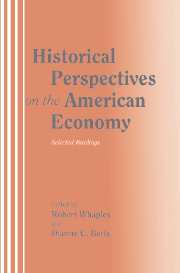Book contents
- Frontmatter
- Contents
- Acknowledgments
- Introduction to students
- Introduction to instructors
- Contributors
- I Introduction
- II Colonial and early national economy
- III Slavery and servitude
- IV The South since the Civil War
- V The rise of American industrial might
- 10 “The railroads: The first modern business enterprises, 1850s–1860s”
- 11 “Notes on the social saving controversy”
- 12 “Industrial structure and the emergence of the modern industrial corporation”
- 13 “The origins of American industrial success, 1879–1940”
- 14 “Federal policy, banking market structure, and capital mobilization in the United States, 1863–1913”
- VI Populism
- VII Women in the economy
- VIII The Great Depression
- Appendix: Basics of regression
- Glossary
- Name index
- Subject index
13 - “The origins of American industrial success, 1879–1940”
Published online by Cambridge University Press: 05 June 2012
- Frontmatter
- Contents
- Acknowledgments
- Introduction to students
- Introduction to instructors
- Contributors
- I Introduction
- II Colonial and early national economy
- III Slavery and servitude
- IV The South since the Civil War
- V The rise of American industrial might
- 10 “The railroads: The first modern business enterprises, 1850s–1860s”
- 11 “Notes on the social saving controversy”
- 12 “Industrial structure and the emergence of the modern industrial corporation”
- 13 “The origins of American industrial success, 1879–1940”
- 14 “Federal policy, banking market structure, and capital mobilization in the United States, 1863–1913”
- VI Populism
- VII Women in the economy
- VIII The Great Depression
- Appendix: Basics of regression
- Glossary
- Name index
- Subject index
Summary
The United States became the world's preeminent manufacturing nation at the turn of the twentieth century. This study considers the bases for this success by examining the factor content of trade in manufactured goods. Surprisingly, the most distinctive characteristic of U.S. manufacturing exports was intensity in nonreproducible natural resources; furthermore, this relative intensity was increasing between 1880 and 1920. The study then asks whether resource abundance reflected geological endowment or greater exploitation of geological potential. It was mainly the latter.
(JEL 042)Recent thinking about American economic performance has been marked by alarm over the country's loss of its “competitive edge.” Most of this discussion is not rooted in an understanding of the historical origins of the economic leadership now thought to be in jeopardy. Modern economists tend to assume that the American advantage has been technological and dates from the remote recesses of history, about as far back as anyone really cares to go. In a volume on U.S. competitiveness, Harvey Brooks writes: “Both our firms and our government, long accustomed to being the technological leaders in almost every field, have until recently measured their performance against domestic rather than foreign competitors” (Bruce R. Scott and George C. Lodge, 1985, p. 331; emphasis added). For one country to maintain a technologically based advantage over others for long historical periods is anomalous, and surely calls for explanation. Indeed, it is difficult to see how policies can respond appropriately to “what we have lost” without knowledge of what it was that we had and how we got it.
- Type
- Chapter
- Information
- Historical Perspectives on the American EconomySelected Readings, pp. 455 - 481Publisher: Cambridge University PressPrint publication year: 1995
- 12
- Cited by



